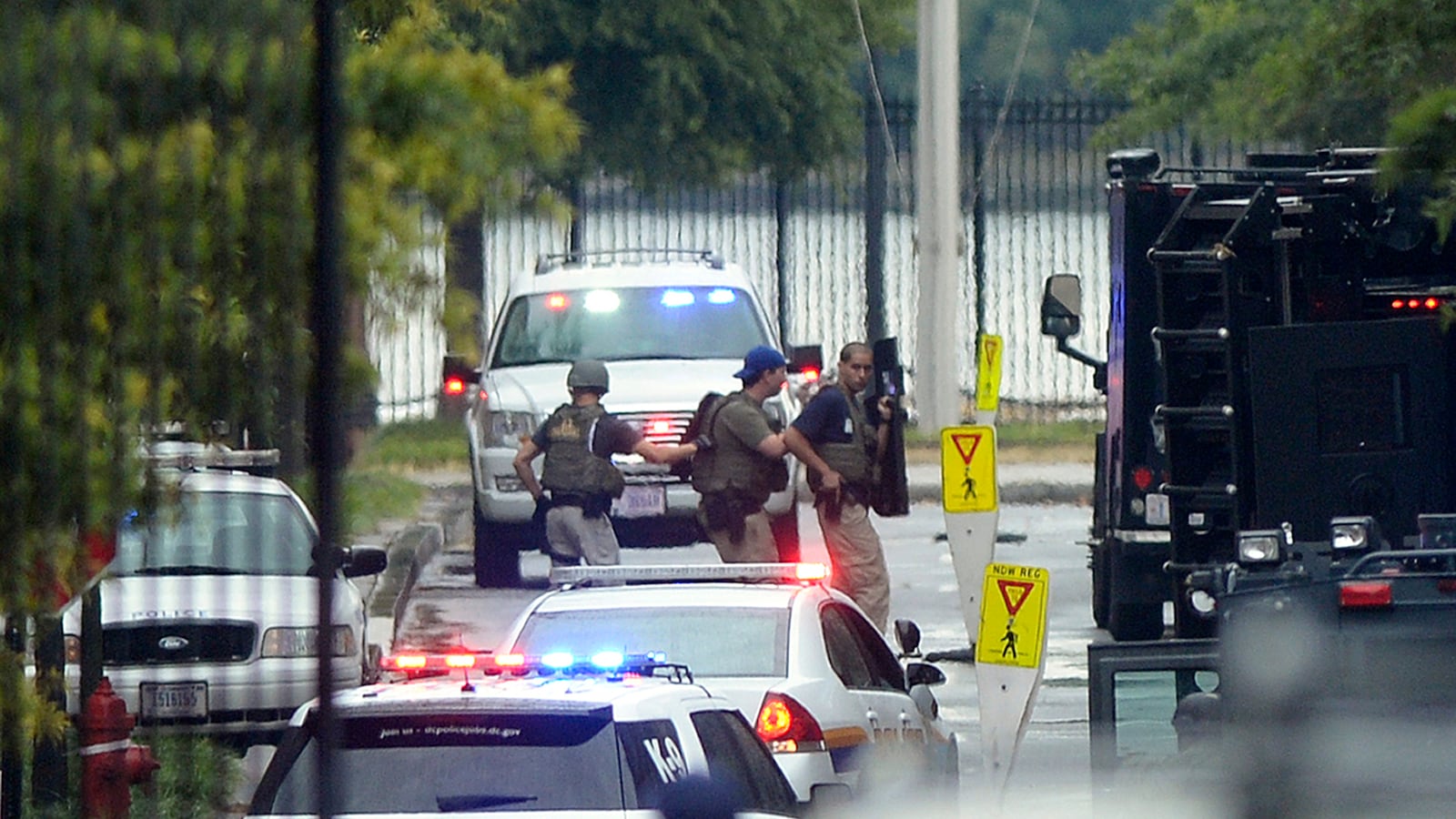Two minutes after the first report of shots fired, two Metropolitan Police units responded to the Navy Yard in Washington, D.C.
After four minutes, five to seven units had arrived. More kept coming, and in those first adrenaline-charged moments nobody was sure where in the sprawling complex to go.
Then, seven minutes in, the cops heard shots coming from Building 197. They raced inside as the workers were fleeing. Somebody had pulled the fire alarm to get people to evacuate, but the sound now made it difficult for the cops to hear their radios.
They had no trouble hearing the booming of Aaron Alexis’s shotgun. He had arrived that morning from a nearby Residence Inn with the shotgun disassembled in a black bag. He had reassembled the weapon in a bathroom and stepped out onto a fourth-floor walkway overlooking an atrium. He commenced firing down on people having their breakfast in the first-floor cafeteria.
The vantage was so murderously perfect as to suggest that he had planned the attack during his previous few days working there. He had bought the shotgun only that weekend after deciding against an AR-15 assault rifle because of the waiting period. He had customized his new gun by etching in the words “better off this way” and “my ELF weapon.” The Navy uses ELF, or extra low frequencies, to communicate with submerged submarines, but Alexis’s message was more likely related to his delusions that somebody was using a kind of big microwave machine to bombard him with “vibrations.”
The cops who now hurried upstairs included Police Officer Scott Williams. He was wounded as he and a number of comrades exchanged fire with Alexis, by one account across the atrium.
Alexis also reportedly traded shots with NCIS agents. He is believed to have used the stairways to go from one level to another, firing as he moved, the shots joined by screams. The Washington Post reports that Navy Capt. Christopher Mercer and several coworkers barricaded themselves in Mercer’s office on the western side of the third floor. Mercer sought shelter under his desk as he used his BlackBerry to message a supervisor who was outside relaying Mercer's information to the police.
Alexis seems to have ducked down an emergency stairwell. A number of shots rang out, apparently as he fired on the people outside, striking a man in the head and killing him.
Then the gunfire ceased and the only sound was that fire alarm as Alexis seemed to vanish. Police kept searching the huge building with its warrens of cubicles and rows of filing cabinets. The most mortal danger threatened to materialize suddenly around every corner, in every doorway, on every staircase.
For an eternity that the clock measured as 15 minutes or maybe 20 or a little more, the police did not encounter Alexis. The Navy supervisor outside messaged the captain hunkered under the desk, asking if the gunman was still inside. The captain was unsure.
Then, according the account in The Washington Post, the captain heard footsteps in the hallway outside, followed by the clicking of a weapon being reloaded, either the shotgun or an automatic pistol that Alexis had taken from a security guard he had shot.
Alexis withdrew to the office next door, and then there came the sound of moving furniture, apparently as he began to prepare his own barricade. The captain messaged his supervisor the coordinates of this adjacent office on the west side of the third floor:
“3(W)20820”
According to a senior law-enforcement source, a Metropolitan Police officer and a U.S. Park Police officer responded. There was a furious gunfight. The firing then ceased.
“Shooter down! Shooter down!” a cop shouted.
The gunman was dead. An FBI agent took his fingerprints with an electronic reader, and they matched those that went on file when Aaron Alexis enlisted in the Navy six years ago.
On Wednesday, the gunman’s mother, Cathleen Alexis, issued a written statement from her Brooklyn home, expressing her grief over the 12 innocents her son murdered in his inexplicable madness.
“I don’t know why he did what he did, and I’ll never be able to ask him why,” she said. “Aaron is now in a place where he can no longer do harm to anyone, and for that I am glad. To the families of the victims, I am so, so very sorry that this has happened. My heart is broken.”
She was consoled by Bishop Gerald Seabrooks, who later said she blames herself, as any mother likely would, even though there is no rational reason to do so. He suggested that the depth of her pain over what her son did is also a measure of her decency.
“A very caring woman,” he said. “An empathetic woman.”
Cathleen Alexis and everybody else has cause to give thanks that the wounded officer, Scott Williams, is on the mend. The head of the Metropolitan Police union, Kristopher Baumann, has expressed outrage on other days that the cops have not had a pay raise in seven years. But on Wednesday he was focused not on zeroes but heroes, on how brave they had been and how well they had worked with equally brave souls from the Transit Police, as well as the Park Police and the U.S. Marshals and NCIS and the FBI and other agencies.
“I have never been prouder,” Baumann said.
One controversy arose after members of the U.S. Capitol Police SWAT team told a reporter that one of their own supervisors had ordered them not to respond to the shooting even though they were less than a minute away when the first report came in.
Had the team been given the go-ahead, they no doubt would have joined the others in showing us all the very best in themselves, from the first moments to the very last of that longest hour.






